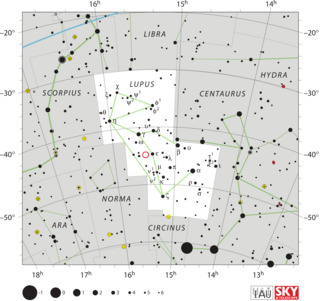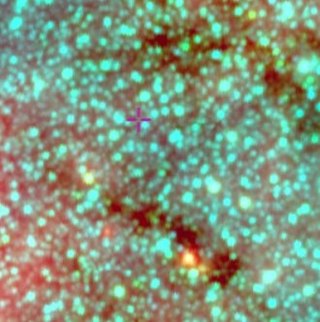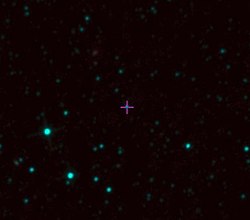
Circinus is a small, faint constellation in the southern sky, first defined in 1756 by the French astronomer Nicolas-Louis de Lacaille. Its name is Latin for compass, referring to the drafting tool used for drawing circles. Its brightest star is Alpha Circini, with an apparent magnitude of 3.19. Slightly variable, it is the brightest rapidly oscillating Ap star in the night sky. AX Circini is a Cepheid variable visible with the unaided eye, and BX Circini is a faint star thought to have been formed from the merger of two white dwarfs. Two sun-like stars have planetary systems: HD 134060 has two small planets, and HD 129445 has a Jupiter-like planet. Supernova SN 185 appeared in Circinus in 185 AD and was recorded by Chinese observers. Two novae have been observed more recently, in the 20th century.

Indus is a constellation in the southern sky first professionally surveyed by Europeans in the 1590s and mapped on a globe by Petrus Plancius by early 1598. It was included on a plate illustrating southern constellations in Bayer's sky atlas Uranometria in 1603. It lies well south of the Tropic of Capricorn but its triangular shape can be seen for most of the year from the Equator. It is elongated from north to south and has a complex boundary. The English translation of its name is generally given as the Indian, though it is unclear which indigenous people the constellation was originally supposed to represent.

Wolf 1061 is an M-class red dwarf star located about 14.1 light-years away in the constellation Ophiuchus. It is the 36th-closest-known star system to the Sun and has a relatively high proper motion of 1.2 seconds of arc per year. Wolf 1061 does not have any unusual spectroscopic features.

NGC 4666 is a spiral galaxy in the equatorial constellation of Virgo, located at a distance of approximately 55 megalight-years from the Milky Way. It was discovered by the German-born astronomer William Herschel on February 22, 1784. It is a member of the Virgo II Groups, a series of galaxies and galaxy clusters strung out from the southern edge of the Virgo Supercluster. John L. E. Dreyer described it as "bright, very large, much extended 45°±, pretty suddenly brighter middle". It is a member of an interacting system with NGC 4668 and a dwarf galaxy, and belongs to a small group that also includes NGC 4632.

NGC 4866 is an unbarred lenticular galaxy located roughly 100 million light-years away in the constellation Virgo. It was first observed by British astronomer Sir William Herschel on January 14, 1787. It is a member of the Virgo Cluster.

RZ Normae is an R Coronae Borealis type variable star in the constellation Norma. It has a baseline magnitude of 10.2, dropping down to dimmer than 16.2 at its minima. It was discovered by the astronomer Sergei Gaposchkin in 1952.

Tabby's Star is an F-type main-sequence star in the constellation Cygnus approximately 1,470 light-years from Earth. Unusual light fluctuations of the star, including up to a 22% dimming in brightness, were discovered by citizen scientists as part of the Planet Hunters project. In September 2015, astronomers and citizen scientists associated with the project posted a preprint of an article describing the data and possible interpretations. The discovery was made from data collected by the Kepler space telescope, which observed changes in the brightness of distant stars to detect exoplanets.

ASASSN-15lh is an extremely luminous astronomical transient event discovered by the All Sky Automated Survey for SuperNovae (ASAS-SN), with the appearance of a superluminous supernova event. It was first detected on June 14, 2015, located within a faint galaxy in the southern constellation Indus, and was the most luminous supernova-like object ever observed. At its peak, ASASSN-15lh was 570 billion times brighter than the Sun, and 20 times brighter than the combined light emitted by the Milky Way Galaxy. The emitted energy was exceeded by PS1-10adi.
The All Sky Automated Survey for SuperNovae (ASAS-SN) is an automated program to search for new supernovae and other astronomical transients, headed by astronomers from the Ohio State University, including Christopher Kochanek and Krzysztof Stanek. It has 20 robotic telescopes in both the northern and southern hemispheres. It can survey the entire sky approximately once every day.

V407 Lupi, also known as Nova Lupi 2016, was a bright nova in the constellation Lupus discovered by All Sky Automated Survey for SuperNovae (ASAS-SN) on 24.00 September 2016. At the time of its discovery, it had an apparent visual magnitude of 9.1. The ASAS-SN team reported that no object at the nova's location brighter than magnitude 17.5 was seen on images taken four days earlier. Wildly incorrect coordinates were published in the announcement telegram, but corrected in a subsequent telegram. It reached a peak brightness of magnitude 5.6, faintly visible to the naked eye, on 25 September 2016.

RZ Piscium is a UX Orionis type variable star 550 light-years (170 pc) away, in the constellation Pisces. Over the years, the star has been found to brighten and dim erratically, dimming by as much as a tenth of its usual luminosity. RZ Piscium has been found to emit large amounts of infrared radiation, suggesting the presence of a substantial mass of gas and dust orbiting the star, possibly from a "disrupted planet".

In astronomy, a disrupted planet is a planet or exoplanet or, perhaps on a somewhat smaller scale, a planetary-mass object, planetesimal, moon, exomoon or asteroid that has been disrupted or destroyed by a nearby or passing astronomical body or object such as a star. Necroplanetology is the related study of such a process. Nonetheless, the result of such a disruption may be the production of excessive amounts of related gas, dust and debris, which may eventually surround the parent star in the form of a circumstellar disk or debris disk. As a consequence, the orbiting debris field may be an "uneven ring of dust", causing erratic light fluctuations in the apparent luminosity of the parent star, as may have been responsible for the oddly flickering light curves associated with the starlight observed from certain variable stars, such as that from Tabby's Star, RZ Piscium and WD 1145+017. Excessive amounts of infrared radiation may be detected from such stars, suggestive evidence in itself that dust and debris may be orbiting the stars.

V906 Carinae, also known as Nova Carinae 2018, was a nova in the Milky Way galaxy which appeared in the constellation Carina, near the 5th magnitude star HD 92063. It was discovered on images taken on 20.32 March 2018 by the All Sky Automated Survey for SuperNovae (ASAS-SN] telescope at the Cerro Tololo Inter-American Observatory. The ASAS-SN group assigned the name ASASSN-18fv to the object. The discovery image was saturated, allowing researchers to determine only that the object was brighter than apparent magnitude 10. An earlier image obtained by ASAS-SN on 26.32 March 2018 showed the nova was a magnitude ~10.4 object at that time, and the object was not detected on ASAS-SN images taken on 15.34 March 2018 and earlier.

SN 2018cow was a very powerful astronomical explosion, 10–100 times brighter than a normal supernova, spatially coincident with galaxy CGCG 137-068, approximately 200 million ly (60 million pc) distant in the Hercules constellation. It was discovered on 16 June 2018 by the ATLAS-HKO telescope, and had generated significant interest among astronomers throughout the world. Later, on 10 July 2018, and after AT 2018cow had significantly faded, astronomers, based on follow-up studies with the Nordic Optical Telescope (NOT), formally described AT 2018cow as SN 2018cow, a type Ib supernova, showing an "unprecedented spectrum for a supernova of this class"; although others, mostly at first but also more recently, have referred to it as a type Ic-BL supernova. An explanation to help better understand the unique features of AT 2018cow has been presented. AT2018cow is one of the few reported Fast Blue Optical Transients (FBOTs) observed in the Universe. In May 2020, however, a much more powerful FBOT than AT2018cow was reportedly observed.

EPIC 204376071 is an M-type star in the constellation of Scorpius. Parallax measurements by the Gaia space observatory put the star at a distance of about 440 light-years from Earth. It is likely a member of the Upper Sco association, and is young enough that it has not yet become a main-sequence star.

VVV-WIT-07 is a unique variable star which presents a sequence of recurrent dimmings with a possible deep eclipse in July 2012. The star, located in the Scorpius constellation about 23,000 ly (7,100 pc) away, is not a binary star, which would eliminate such a system from explaining the various observed dimmings.

HD 139139 is likely part of a bound pair system of main sequence stars about 350 light-years away from Earth in the constellation Libra. HD 139139 is a G-type main-sequence star, a little larger and more luminous than the Sun, and at an almost identical temperature. It has an apparent magnitude of 9.8. The companion star is thought to be a K5-7 red dwarf 3.3″ away from HD 139139. It is about three magnitudes fainter and has a temperature of between 4,100 and 4,300 K. Both stars have a similar proper motion, meaning they may form a gravitationally-bound binary pair.

YZ Reticuli, also known as Nova Reticuli 2020 was a naked eye nova in the constellation Reticulum discovered on July 15, 2020. Previously it was known as a VY Sculptoris type object with the designation MGAB-V207.

















